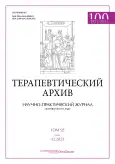Predictive capability of Cys112Arg single nucleotide polymorphisms of the apolipoprotein E gene in assessing the risk of immediate and early post-traumatic seizures
- 作者: Kriukova K.K.1, Alexandrova E.V.2, Voskresenskaya O.N.1, Podlepich V.V.2, Kravchuk A.D.2, Rytkin E.I.3, Latyshev Y.A.2, Kudlay D.A.1, Sologova S.S.1, Albagachiev S.A.1, Mandrik M.A.1
-
隶属关系:
- Sechenov First Moscow State Medical University (Sechenov University)
- Burdenko National Medical Research Center for Neurosurgery
- Northwestern University
- 期: 卷 95, 编号 12 (2023)
- 页面: 1128-1132
- 栏目: Original articles
- URL: https://bakhtiniada.ru/0040-3660/article/view/258740
- DOI: https://doi.org/10.26442/00403660.2023.12.202492
- ID: 258740
如何引用文章
全文:
详细
This study is aimed at investigating epileptic seizures, one of the consequences of traumatic brain injury (TBI). Immediate and early post-traumatic seizures, as well as late post-traumatic epileptic seizures or post-traumatic epilepsy, can have different pathogenetic bases. The following key risk factors associated with post-traumatic epilepsy are known: duration of unconsciousness, gunshot wounds, intracranial hemorrhage, diffuse axonal injury, prolonged (more than 3 days) post-traumatic amnesia, acute subdural hematoma with surgical evacuation, immediate and early post-traumatic epileptic seizures, fracture of the skull bones. The role of genetic factors in post-traumatic seizures is poorly understood due to the complexity and multiple causal mechanisms. This paper addresses the role of genetic factors in the occurrence and severity of epileptic events in patients with TBI. In particular, we investigated the role of the Cys112Arg single nucleotide polymorphism of the apolipoprotein E gene. Apolipoprotein E is known for its role in the transport and metabolism of lipids and, therefore, the development of cardiovascular diseases; it is also associated with Alzheimer's disease and has recently been studied in the context of association with epilepsy. The study shows an association between this polymorphism and the risk of immediate and early epileptic seizures in patients with severe TBI.
作者简介
Kseniia Kriukova
Sechenov First Moscow State Medical University (Sechenov University)
Email: ks.k.kryukova@gmail.com
ORCID iD: 0000-0001-6714-9780
аспирант каф. нервных болезней и нейрохирургии
俄罗斯联邦, MoscowEvgenia Alexandrova
Burdenko National Medical Research Center for Neurosurgery
Email: ks.k.kryukova@gmail.com
ORCID iD: 0000-0001-5327-314X
канд. мед. наук, врач-невролог
俄罗斯联邦, MoscowOlga Voskresenskaya
Sechenov First Moscow State Medical University (Sechenov University)
Email: ks.k.kryukova@gmail.com
ORCID iD: 0000-0002-7330-633X
д-р мед. наук, проф. каф. нервных болезней и нейрохирургии
俄罗斯联邦, MoscowVitaliy Podlepich
Burdenko National Medical Research Center for Neurosurgery
Email: ks.k.kryukova@gmail.com
ORCID iD: 0000-0002-3424-3815
канд. мед. наук, врач-реаниматолог
俄罗斯联邦, MoscowAlexander Kravchuk
Burdenko National Medical Research Center for Neurosurgery
编辑信件的主要联系方式.
Email: ks.k.kryukova@gmail.com
ORCID iD: 0000-0002-3112-8256
д-р мед. наук, врач-нейрохирург, зав. отд-нием черепно-мозговой травмы
俄罗斯联邦, MoscowEric Rytkin
Northwestern University
Email: ks.k.kryukova@gmail.com
ORCID iD: 0000-0003-2511-0655
докторант, науч. сотр.
美国, ChicagoYaroslav Latyshev
Burdenko National Medical Research Center for Neurosurgery
Email: ks.k.kryukova@gmail.com
ORCID iD: 0000-0002-7125-5962
канд. мед. наук, врач-нейрохирург
俄罗斯联邦, MoscowDmitry Kudlay
Sechenov First Moscow State Medical University (Sechenov University)
Email: ks.k.kryukova@gmail.com
ORCID iD: 0000-0003-1878-4467
чл.-кор. РАН, д-р мед. наук, проф. каф. фармакологии Института фармации им. А.П. Нелюбина
俄罗斯联邦, MoscowSusanna Sologova
Sechenov First Moscow State Medical University (Sechenov University)
Email: ks.k.kryukova@gmail.com
ORCID iD: 0000-0002-8526-7147
канд. биол. наук, доц., зав. учебной частью каф. фармакологии Института фармации им. А.П. Нелюбина
俄罗斯联邦, MoscowSabr Albagachiev
Sechenov First Moscow State Medical University (Sechenov University)
Email: ks.k.kryukova@gmail.com
ORCID iD: 0009-0003-5489-7001
ординатор каф. фармацевтической технологии Института фармации им А.П. Нелюбина
俄罗斯联邦, MoscowMark Mandrik
Sechenov First Moscow State Medical University (Sechenov University)
Email: ks.k.kryukova@gmail.com
ORCID iD: 0000-0002-3558-9615
ассистент каф. фармацевтической технологии Института фармации им. А.П. Нелюбина
俄罗斯联邦, Moscow参考
- Hyder AA, Wunderlich CA, Puvanachandra P, et al. The impact of traumatic brain injuries: A global perspective. NeuroRehabilitation. 2007;22:341-53. doi: 10.3233/NRE-2007-22502
- Salazar AM, Grafman J. Role of Antiseizure Prophylaxis Following Head Injury. Post-traumatic epilepsy: clinical clues to pathogenesis and paths to prevention. Handb Clin Neurol. 2015;128:525-38. doi: 10.1016/B978-0-444-63521-1.00033-9
- Agrawal A, Timothy J, Pandit L, Manju M. Post-traumatic epilepsy: An overview. Clin Neurol Eurosurg. 2006;108:433-9. doi: 10.1016/j.clineuro.2005.09.001
- Cecile JW, Ioannidis JPA, Bedrosian S, et al. Strengthening the reporting of genetic risk prediction studies (GRIPS): explanation and elaboration: grips statement: explanation and elaboration. Eur J Clin Invest. 201;141:1010-35. doi: 10.1111/j.1365-2362.2011.02493.x
- Boone DR, Weisz HA, Willey HE, et al. Traumatic brain injury induces long-lasting changes in immune and regenerative signaling. PloS One. 2019;14. doi: 10.1371/journal.pone.0214741
- Jarrahi A, Braun M, Ahluwalia M, et al. Revisiting Traumatic Brain Injury: From Molecular Mechanisms to Therapeutic Interventions. Biomedicines. 2020;8:389. doi: 10.3390/biomedicines8100389
- Werner C, Engelhard K. Pathophysiology of traumatic brain injury. Br J Anaesth. 2007;99:4-9. doi: 10.1093/bja/aem131
- Vespa PM, Nuwer MR, Nenov V, et al. Increased incidence and impact of nonconvulsive and convulsive seizures after traumatic brain injury as detected by continuous electroencephalographic monitoring. J Neurosurg. 1999;91:750-60. doi: 10.3171/jns.1999.91.5.0750
- Zimmermann LL, Diaz-Arrastia R, Vespa PM. Seizures and the Role of Anticonvulsants After 15. Traumatic Brain Injury. Neurosurg Clin N Am. 2016;27:499-508. doi: 10.1016/j.nec.2016.06.001
- Misra S, Quinn TJ, Falcone GJ, et al. Impact of genetic polymorphisms on the risk of epilepsy amongst patients with acute brain injury: A systematic review. Eur J Neurol. 2023;30:1791-800. doi: 10.1111/ene.15777
- Lamoureux L, Marottoli FM, Tseng KY, Tai LM. APOE4 Promotes Tonic-Clonic Seizures, an Effect Modified by Familial Alzheimer’s Disease Mutations. Front Cell Dev Biol. 2021;9:656521. doi: 10.3389/fcell.2021.656521
- Raulin AC, Doss SV, Trottier ZA, et al. ApoE in Alzheimer’s disease: pathophysiology and therapeutic strategies. Mol Neurodegener. 2022;17:72. doi: 10.1186/s13024-022-00574-4
- Miller MA, Conley Y, Scanlon JM, et al. APOE genetic associations with seizure development after severe traumatic brain injury. Brain Inj. 2010;24:1468-77. doi: 10.3109/02699052.2010.520299
- Клинические рекомендации «Очаговая травма головного мозга» (утв. Минздравом России). М., 2022 [Klinicheskie rekomendatsii “Ochagovaia travma golovnogo mozga (utv. Minzdravom Rossii). Moscow, 2022 (in Russian)].
补充文件








